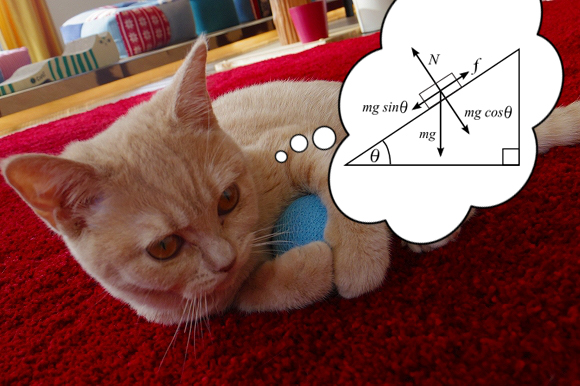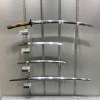
As long as it’s with regards to Newton’s laws of motion and electromagnets, research shows curiosity does not kill the cat after all.
A team at Kyoto University recently ran tests to learn more about cats’ ability to use logical thinking. In this study, researchers examined if a cat would expect to see something based on a sound it heard. Previous attempts had been made with other animals, but the failure rate was high.
As it turned out, other animals, such as primates, were turned off by unknown sounds for fear that it might be a threat. On the other hand, cats have the unique personality trait of interpreting a noise as something they might want to kill and eat and were more intrigued by it.
So the team visited some cat cafes and homes of cat owners with a specially designed steel container and iron object to go inside. The container was also fit with an electromagnet allowing the object to cling to the bottom when needed.
An examiner would then approach an individual feline in an isolated environment and call their name to get their attention. They would then shake the box and turn it upside down so that the object would fall out. While taking breaks in between, they repeated the procedure but used the magnet to create different causes and effects.
The examiners also video recorded the cats’ reactions for detailed analysis and smiled warmly throughout because this whole testing was all so gosh-darned precious.
What they found was the cats were mostly interested in cases 2 and 3 where unexpected results occurred. Interest was measured by the time they spent staring at the container. This means that the cats were possibly applying laws of physics to the apparatus and expecting an object to fall out once they heard a sound and vice versa.
It should be noted that not all cats demonstrated an equal thirst for knowledge. Out of 45 tested cats, 15 were refused because they expressed either fear or indifference at the experiment – knowing cats, the majority of them probably felt the latter.
It certainly seems as though an Ig Noble Prize is in the works for this breakthrough in animal inference research and the team is far from finished. They would also like to test cats’ hearing more in depth to learn whether they can determine how many objects are in a box and whether to expect a certain number to fall out of the container.
Once we are in possession of this knowledge, the human race can finally…hmm, like apply it to other fields of study and stuff. Alright, I don’t know about humanity but I can finally guilt my daughter into doing her science homework by saying even a cat can do it.
Source: Sputnik News (Japanese), Ars Technica (English), Springer Link (English)
Images: RocketNews24
Friction Diagram: Wikipedia/Mets501


 Japanese universities determine cats know the names of other cats
Japanese universities determine cats know the names of other cats Japan now has a traffic safety video for cats to watch to help keep them safe on the streets
Japan now has a traffic safety video for cats to watch to help keep them safe on the streets Japanese team wins Ig Nobel prize for confirming that banana peels are in fact slippery
Japanese team wins Ig Nobel prize for confirming that banana peels are in fact slippery Japanese doctor wins Ig Nobel Prize for learning we can kind of breathe in through our butts
Japanese doctor wins Ig Nobel Prize for learning we can kind of breathe in through our butts Data shows Fukui Prefecture may be the best place to live in Japan, but survey results differ
Data shows Fukui Prefecture may be the best place to live in Japan, but survey results differ Station of despair: What to do if you get stuck at the end of Tokyo’s Chuo Rapid Line
Station of despair: What to do if you get stuck at the end of Tokyo’s Chuo Rapid Line This downtown Tokyo cafe is like a time machine that takes you back 50 years into the past
This downtown Tokyo cafe is like a time machine that takes you back 50 years into the past Japanese government will check and judge new baby name pronunciations, presents guidelines
Japanese government will check and judge new baby name pronunciations, presents guidelines Totoro towels gently glow in the dark to set the Ghibli nighttime mood in your home【Photos】
Totoro towels gently glow in the dark to set the Ghibli nighttime mood in your home【Photos】 How to get all-you-can eat doughnuts at Mister Donut for just 12 bucks!
How to get all-you-can eat doughnuts at Mister Donut for just 12 bucks! Japanese company develops classy heavy metal band frames for glasses
Japanese company develops classy heavy metal band frames for glasses Nakano Broadway sells a fukubukuro lucky bag for foreigners, but is it a good deal or a scam?
Nakano Broadway sells a fukubukuro lucky bag for foreigners, but is it a good deal or a scam? Starbucks teams up with 165-year-old Kyoto doll maker for Year of the Snake decorations【Photos】
Starbucks teams up with 165-year-old Kyoto doll maker for Year of the Snake decorations【Photos】 Yakuza vending machines coming to real-world Tokyo neighborhood that inspired Like a Dragon games
Yakuza vending machines coming to real-world Tokyo neighborhood that inspired Like a Dragon games Genuine Muramasa blade and Muromachi katana on display at Tokyo’s Touken Ranbu store【Photos】
Genuine Muramasa blade and Muromachi katana on display at Tokyo’s Touken Ranbu store【Photos】 One of Japan’s rarest sweets is a sell-out hit that looks and tastes like frost
One of Japan’s rarest sweets is a sell-out hit that looks and tastes like frost Studio Ghibli showcases traditional craftsmanship with new wallet range
Studio Ghibli showcases traditional craftsmanship with new wallet range Mysterious light-up rainy night-sound Totoro figure doesn’t actually show a scene from the anime
Mysterious light-up rainy night-sound Totoro figure doesn’t actually show a scene from the anime Major Japanese city is abolishing extracurricular activities at all of its middle schools
Major Japanese city is abolishing extracurricular activities at all of its middle schools Over 800 Studio Ghibli anime world paintings compiled in beautiful new hardcover art book【Pics】
Over 800 Studio Ghibli anime world paintings compiled in beautiful new hardcover art book【Pics】 Spirited Away and Princess Mononoke plushies show a softer side of formidable Ghibli characters
Spirited Away and Princess Mononoke plushies show a softer side of formidable Ghibli characters Shakey’s is back! All-you-can-eat pizza chain returns to downtown Tokyo’s Shinjuku
Shakey’s is back! All-you-can-eat pizza chain returns to downtown Tokyo’s Shinjuku Studio Ghibli tea blends contain ingredients inspired by My Neighbour Totoro
Studio Ghibli tea blends contain ingredients inspired by My Neighbour Totoro Possessing Harry Potter’s Sword of Godric Gryffindor is now illegal in Japan
Possessing Harry Potter’s Sword of Godric Gryffindor is now illegal in Japan Uniqlo announces first-ever collaboration with horror manga master Junji Ito【Photos】
Uniqlo announces first-ever collaboration with horror manga master Junji Ito【Photos】 J-pop mega star Ado reveals she’s been living in the U.S., may not understand language acquisition
J-pop mega star Ado reveals she’s been living in the U.S., may not understand language acquisition Starbucks Japan is calling it quits with paper straws
Starbucks Japan is calling it quits with paper straws Studio Ghibli releases new range of cardigans for anime fans
Studio Ghibli releases new range of cardigans for anime fans Japan’s most popular castle raising ticket prices by up to 200 percent for non-local tourists
Japan’s most popular castle raising ticket prices by up to 200 percent for non-local tourists Furikake rice seasoning sales are soaring, which is bad news for Japan as a whole
Furikake rice seasoning sales are soaring, which is bad news for Japan as a whole Studio Ghibli heroine cardigans give you warmth and strength to face everyday challenges
Studio Ghibli heroine cardigans give you warmth and strength to face everyday challenges Eight unforgettable hot springs, as recommended by Japan’s “Professor Bath”
Eight unforgettable hot springs, as recommended by Japan’s “Professor Bath” McDonald’s new Happy Meals offer up cute and practical Sanrio lifestyle goods
McDonald’s new Happy Meals offer up cute and practical Sanrio lifestyle goods Foreign tourists on Shinkansen bullet train break suitcase etiquette, angering local passengers
Foreign tourists on Shinkansen bullet train break suitcase etiquette, angering local passengers [Deleted] Article written for April Fool’s Day 2018
[Deleted] Article written for April Fool’s Day 2018 Japanese government to make first change to romanization spelling rules since the 1950s
Japanese government to make first change to romanization spelling rules since the 1950s Foreigner’s request for help in Tokyo makes us sad for the state of society
Foreigner’s request for help in Tokyo makes us sad for the state of society Japanese convenience store Family Mart announces abolishment of eat-in spaces
Japanese convenience store Family Mart announces abolishment of eat-in spaces Life-size vibrating Legend of Zelda Master Sword for sale from Nintendo【Photos】
Life-size vibrating Legend of Zelda Master Sword for sale from Nintendo【Photos】 Princesses, fruits, and blacksmiths: Study reveals the 30 most unusual family names in Japan
Princesses, fruits, and blacksmiths: Study reveals the 30 most unusual family names in Japan Studio Ghibli releases free-download board game — Here’s how to play it without reading Japanese
Studio Ghibli releases free-download board game — Here’s how to play it without reading Japanese Clever Japanese pet owners find perfect cat beds…at IKEA! 【Photos】
Clever Japanese pet owners find perfect cat beds…at IKEA! 【Photos】 Japan’s cat cafes expected to get permanent permission to operate past 8 p.m.
Japan’s cat cafes expected to get permanent permission to operate past 8 p.m. These adorable Japanese stacking cat boxes will keep you company and your living space organized
These adorable Japanese stacking cat boxes will keep you company and your living space organized Yawns can be contagious for cats too, Japanese pet owner’s adorable felines prove【Photo】
Yawns can be contagious for cats too, Japanese pet owner’s adorable felines prove【Photo】 Can these Japanese kitties accurately predict the advancing teams of the World Cup?
Can these Japanese kitties accurately predict the advancing teams of the World Cup? Japan now has diapers specially for cats
Japan now has diapers specially for cats Capcom Japan’s April Fool is awesome, nyansensical
Capcom Japan’s April Fool is awesome, nyansensical Is Japan’s Cat Island in danger of turning into the Island of Fat Cats?
Is Japan’s Cat Island in danger of turning into the Island of Fat Cats? Excessive dog pee to blame for traffic light collapse, Japanese police think
Excessive dog pee to blame for traffic light collapse, Japanese police think Japan to release a Complimenting Card Game through crowdfunding
Japan to release a Complimenting Card Game through crowdfunding Can cats cut the cost of power? Japanese delivery company with a cat-themed name investigates
Can cats cut the cost of power? Japanese delivery company with a cat-themed name investigates Japan has a cat aptitude test to show off how much you know about our feline friends
Japan has a cat aptitude test to show off how much you know about our feline friends Here’s a magic frame that can warp a cat’s butt through your wall
Here’s a magic frame that can warp a cat’s butt through your wall Small children have magnetic “cat-attracting” ability, adorable photos from Japan show
Small children have magnetic “cat-attracting” ability, adorable photos from Japan show Lawson convenience stores in Kyoto to begin offering cancer screenings
Lawson convenience stores in Kyoto to begin offering cancer screenings
Leave a Reply